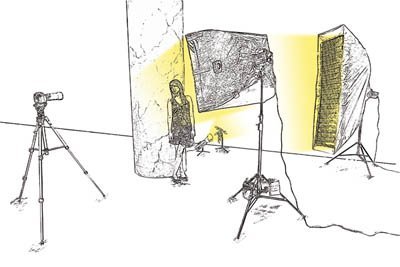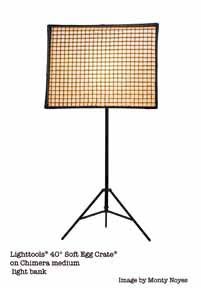articles/Lighting/eggcratelightmodifiers-page2
Lighting for digital - Dave Montizambert looks at egg-crate light modifiers - part 2 of 1 2
by Dave Montizambert Published 21/10/2009

Egg-crate Cell Sizes:
The size of the egg crate squares, called cell size, have different dimensions to create different spreads of light. For instance, Lighttools Egg-crates have five different cell size configurations, 60˚, 50˚, 40˚, 30˚, and 20˚, plus two other hybrids, a 20/60˚ and a 30˚/50˚ for strip-light soft-boxes. As you can imagine, a 60˚ eggcrate gives you a much wider (vertically as well as horizontally) pattern of light than the 20˚which is quite tight. To give you an idea, the cell size of the 60˚ cells are 8.8 cm horizontal by 8.8 cm vertical by 5 cm deep, whereas the 20˚ cells are 1.85 cm horizontal by 1.85 cm vertical by 5 cm deep. The 20˚/60˚ and the 30˚/50˚ are used on strip soft-boxes. The 2x6 foot strip soft-box, used as a separation light on Natasha, had a 20˚/60˚ egg-crate on it. The 20˚/60˚ cell size is 1.85 cm by 8.8 cm by 5 cm deep. So, the smaller the cell size, the more contained and directional is the light. I generally place the light-source at the distance I want for light quality - closer creates a softer wrap-around light quality, while further creates a harder light quality - and then I choose the appropriate egg-crate to puddle the light on the subject just the way I want. This is often done by trial and error, starting with an educated guess as to which egg crate is needed, installing it, and then swapping it out for another size if necessary. Egg-crates are great, you should, however, know that they do eat up some light (¼ to 3 stops depending on cell size and subject distance from light) and egg-crates can make your large light source appear slightly smaller to the subject making the light quality slightly harder than without. Also egg-crates are not cheap, they are very labour intensive to manufacture because they are made by hand taking between two hours and a day, depending on the size of the cells and the size of the soft-box it is intended for.

Lighting Breakdown:
In Image 03 A, Natasha is lit by a 3x4 foot medium Chimera softbox oriented horizontally to diminish specular contrast (lower glare) on faux marble pillar. When lighting any cylinder with a rectangular light-source, placing the light horizontally spreads the specular highlight out more, diminishing its brightness, whereas orienting the light-source vertically makes for a smaller, brighter specular highlight. I wanted to keep this sheen on the pillar way below 255 level of brightness so that there would be enough detail left that, if I so desired, could later drop the specular brightness further with the Burn tool in Photoshop or the Adjustment Brush in Adobe Camera Raw or Lightroom. This 3x4 foot mainlight source was positioned up high to concentrate its light onto Natasha's head and shoulders. The power of this light was set to correctly expose Natasha at f4.
In Image 03 B, I added a 40˚ Lighttools Soft Egg Crate to create a gradual fall-off of light from Natasha's chest to knees and to keep main-light spill off the dark grey seamless paper backdrop. The rheostat power control on this light was increased by one stop to compensate for the one stop of light absorbed by the egg-crate. In Image 03 C, a 2x6 foot strip light soft-box fitted with a 60˚ eggcrate was placed behind and to the camera-right side of Natasha to provide a little separation lighting on her side, it also created some extra highlights on her hair. An incident meter reading of this light striking Natasha read two stops below the f4 camera aperture setting.
In Image 03 D, a light without any diffusion, only its reflector is placed on the floor behind and to the camera-left side of Natasha and pointed up at the dark grey seamless paper background. To create the illusion of depth in the background, a tree branch full of leaves is placed in front of this background light to create interesting shadow forms on the dark gray seamless. The brightest point of this lighting reads ½ stop darker than middle gray and gradates down to five stops darker in the dark areas when read with a 1˚ reflective spot meter.
Dave Montizambert
Dave Montizambert lectures internationally on lighting, digital photography and Adobe Photoshop. He is also a published author having written two books on lighting and digital photography (publisher Amherst Media) plus numerous magazine articles on these topics in North America and in Europe. Dave also creates Photoshop tutorial CDs & DVDs for www.software-cinema.com. Dave is available for lectures and workshops in your area and can be reached at montizambert@telus.net or www.montizambert.com
If you would like to learn more about digital lighting, check out Dave's book, Creative Lighting Techniques, available through Amherst Media and the SWPP bookstore.
Please Note:
There is more than one page for this Article.
You are currently on page 2
- Lighting for digital - Dave Montizambert looks at egg-crate light modifiers page 1
- Lighting for digital - Dave Montizambert looks at egg-crate light modifiers page 2
1st Published 21/10/2009
last update 09/12/2022 14:53:44
More Lighting Articles
There are 0 days to get ready for The Society of Photographers Convention and Trade Show at The Novotel London West, Hammersmith ...
which starts on Wednesday 15th January 2025





